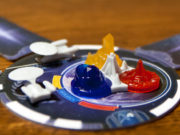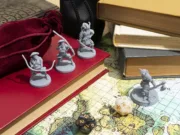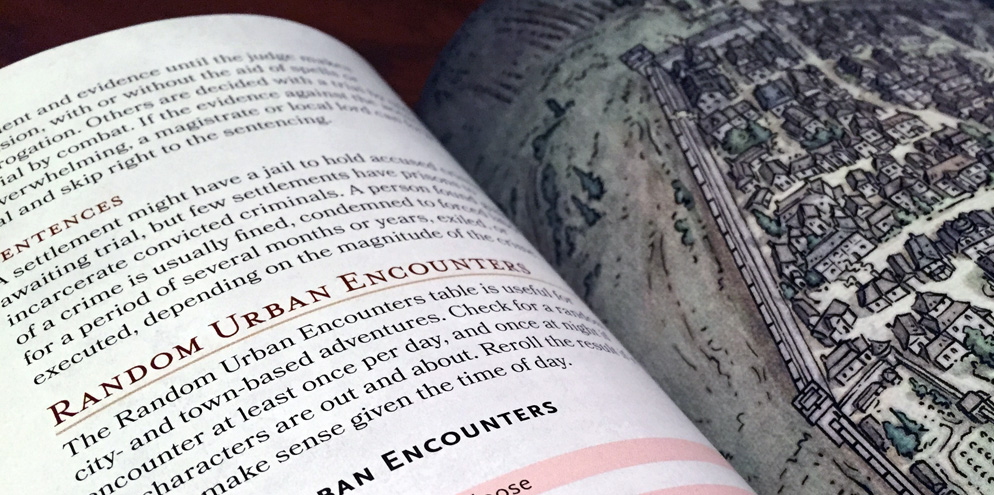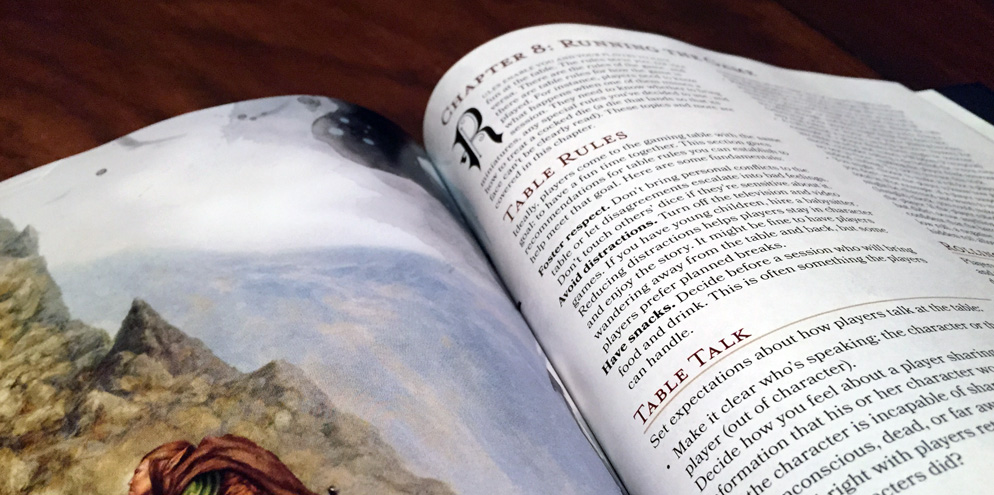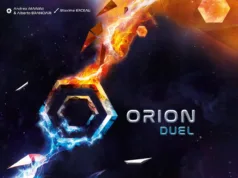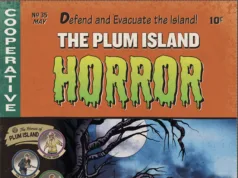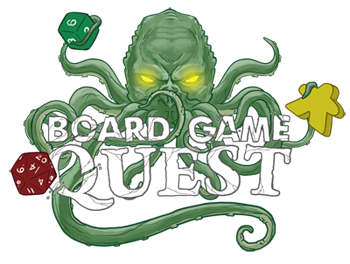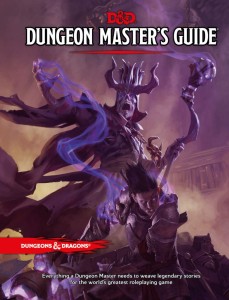 We are finally here, the last book of the Dungeons and Dragons 5th edition “core set”. When they first announced that the roll out of the core books would be a months long process, I was a little unsure of the strategy. I’m used to getting my hands on all three books at once and, as my wife will attest to, I hate change. But it seems to have worked out OK. The Player’s Handbook was outstanding and the Monster Manual was a love letter to DMs. Truth be told, we were able to play the game just fine with the staggered roll out.
We are finally here, the last book of the Dungeons and Dragons 5th edition “core set”. When they first announced that the roll out of the core books would be a months long process, I was a little unsure of the strategy. I’m used to getting my hands on all three books at once and, as my wife will attest to, I hate change. But it seems to have worked out OK. The Player’s Handbook was outstanding and the Monster Manual was a love letter to DMs. Truth be told, we were able to play the game just fine with the staggered roll out.
So now it’s time to dive into the final book in the set, the Dungeon Master’s Guide. Even though I’ve ran countless campaigns as a dungeon master (DM), I rarely read the Dungeon Master’s Guide (DMG) cover to cover. It’s always been more of a tool for me to use piece-meal as needed. So what do I think of a book that’s targeted only to a specific section of the RPG market? Let’s find out.
The 5th edition’s Dungeon Master’s Guide clocks in at over 300 pages and covers a broad variety of topics. If you are strictly a player, then the book is obviously not for you. You may browse the section of magic items, but for the most part, you won’t ever need to crack the cover. However, if you are a dungeon master, especially one that loves to tinker with your game and campaigns, then take note, this book is your bible. The DMG is broken out into 4 main sections that each have their own focus. We’ll take a look at each of these in turn and talk about the highlights.
Master of Worlds
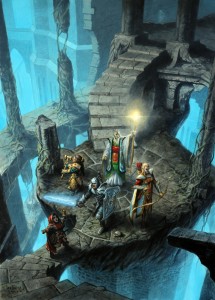 In case you can’t guess, this section is all about world building. This can be quite a daunting task as you need to think of a lot of things when you are creating a world for your players. For one campaign, a long time ago, I built a world from scratch for my players and let me tell you, it was quite the process. There are many things you need to think of: gods, maps, history, currency, countries, races, governments…and the list goes on.
In case you can’t guess, this section is all about world building. This can be quite a daunting task as you need to think of a lot of things when you are creating a world for your players. For one campaign, a long time ago, I built a world from scratch for my players and let me tell you, it was quite the process. There are many things you need to think of: gods, maps, history, currency, countries, races, governments…and the list goes on.
This chapter gives the reader a solid foundation to start with in creating their world. While not the most comprehensive guide to world building (really, this could be a book on its own) it gives you a lot to think about and many suggestions. If you are looking to get your feet wet in building your own world, this will be a great tool to have.
After that, the section moves on into campaign creation, which will probably be more relevant to many DMs. I suspect that most dungeon masters want to create ongoing campaigns for their players as that’s much more fun that constantly running “one offs”. This chapter talks about hooks, timing, play styles, and ending your campaign. All good things to think about.
The final part of this section talks about the Multiverse. To be honest, I never dabbled much in the planes, having most of my campaigns rooted in good old terra firma. Occasionally I’d send my players on an adventure to an outer plane, but that was quite rare. But if the planes are your thing, there are 26 pages here for you to read through. For the rest, you’ll probably blow through this part and move to…
Master of Adventures
While the previous chapter helped you build your campaigns, this sections dials it down to more of a granular approach and helps you create adventures and encounters (and combine the two).
For adventures, if gives you a few different types to think about. Maybe you want to have a game based around a specific event. Perhaps there is a mystery to be solved or some political intrigue. Are there complications? Perhaps a plot twist? This chapter has ideas on all of that.
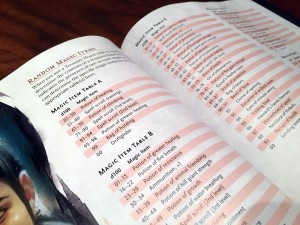 Once you’ve got your overall adventure framed out, it’s time to start encounter building. One of the great things about this part is that it helps DMs build out a balanced encounter. Experienced DMs will recognize the XP Threshold chart that has been around for many editions. Finally the chapter closes off with random encounters, a tool that’s in just about every DMs box. It gives some good tidbits on why you should have them to help new DMs and also gives a sample chart to roll on.
Once you’ve got your overall adventure framed out, it’s time to start encounter building. One of the great things about this part is that it helps DMs build out a balanced encounter. Experienced DMs will recognize the XP Threshold chart that has been around for many editions. Finally the chapter closes off with random encounters, a tool that’s in just about every DMs box. It gives some good tidbits on why you should have them to help new DMs and also gives a sample chart to roll on.
The section moves on to NPC creation. Outside of an arch-villain for my campaigns, I rarely build fully fleshed out NPCs. The ones that I don’t need stat blocks for, I just role play (usually with some kind of horrible accent). For ones that may end up in combat, I usually would just grab a pregen out of the monster manual. But if you need help in creating a fully fleshed out NPC, you are walked through the creation with a host of charts to randomly determine the NPC’s characteristics.
The chapter closes out with what most people were probably waiting for, magic items. With all my time as a DM, this was the section I most used out of a DMG. From random treasure tables to artifacts, just about everything you’d expect is here. All items fall into the standard 5th edition rule set and keep with the streamlined feel you’d expect from this edition. Nothing really felt out-of-place and many items function like their legacy counter parts. The broach of shielding still makes you immune to magic missiles, pearls of power gives you spell slots back, and a portable hole still makes a hole (just don’t place it in your bag of holding).
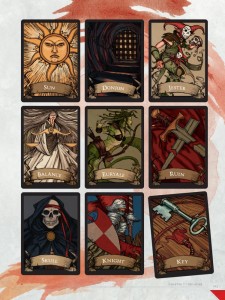 Maybe stat boosting items have capped values, which fits with 5th editions bounded accuracy rules. For example, the Gauntlets of Ogre power makes your strength score 19, instead of giving you a set bonus like it had in legacy editions. Even magic swords cap out at a +3 bonus. It seems that the designers went through all the magic items with a fine tooth comb to keep them in line with 5th edition’s goals.
Maybe stat boosting items have capped values, which fits with 5th editions bounded accuracy rules. For example, the Gauntlets of Ogre power makes your strength score 19, instead of giving you a set bonus like it had in legacy editions. Even magic swords cap out at a +3 bonus. It seems that the designers went through all the magic items with a fine tooth comb to keep them in line with 5th edition’s goals.
In addition to the more common magic items, there are also powerful and legendary ones. A paladin can obtain his Holy Avenger (which also caps out at +3) and there is the classic thunderous item the Deck of Many Things, also known as the campaign wrecker.
The Master of Adventurers section closes off with rules for creating sentient magic items and artifacts, as well as a few example of each. Artifacts rarely would make it into my campaign world, but they are an important part of history and make for some great epic level campaign hooks. If for some reason your players need to find an Orb of the Dragonkind, you’ve now got rules for it.
Master of Rules
Welcome to the hackers section of the DMG. This section starts off with a some tips that just about every DM should read, especially new ones. It provides a lot of information for running great D&D games and briefly addresses common issues such as table talk, “metagaming” and missing players. It also has a number of pages talking about running smooth encounters, both role-playing and combat.
Where it really gets into the fun stuff is when it goes into the different modifications you can make to your game. Want to use hexes instead of squares? Rules for that. Want to add in flanking and facing for your minis? Sure, why not.
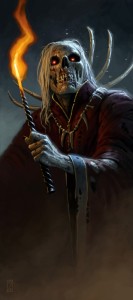 I was actually pretty excited to see a whole section on running a Chase encounter. I remember these from my days of playing Spycraft and thought it was a great idea. I hope someday to have a DM run us through one and see how it compares.
I was actually pretty excited to see a whole section on running a Chase encounter. I remember these from my days of playing Spycraft and thought it was a great idea. I hope someday to have a DM run us through one and see how it compares.
This section is also where the rules for poisons and diseases are. Most DMs will probably pull these out of their bag of tricks at some point. I was a little bummed to not see more examples of each. Previous iterations of the DMG had listed out many diseases and poisons you could throw at your players. Now we only get a couple of diseases and a handful of poisons and are expected to make our own up past that.
Some of the variant rules I found particularly interesting were the alternate proficiency and the honor and sanity scores. With alternate proficiency, players gain a die that increases in level rather than a set bonus. Honor and Sanity are 2 additional ability scores that are added to your character. I could see both being used in particularly thematic campaigns.
For those that want a little tech in their world, you’ll find rules for using guns and explosives. While the old classic, the arquebus, didn’t make the cut, there are stats for muskets, modern weapons, and even future and alien tech. So for DMs that want to re-run the old and classic Barrier Peaks mod, you’ve got a solid foundation to build from.
The section closes off with monster creation. Rarely have I created my own monster (especially when there is a wealth of awesome ones in the Monster Manual), but this section was quite thorough and should provide the framework for anyone with the desire.
Appendices
The book closes out with three appendices. The first is a series of tables to help you create random dungeons. This appendix is 12 pages in length and should guide you through the process. I can’t say this is a “must have” inclusion for me, but if you were trying to quickly build an encounter, I could see it being handy.
 The next appendix is a list of monsters by environment and monsters by challenge rating. If you remember our review of the Monster Manual, the missing “monsters by challenge rating” was the one glaring flaw in an otherwise outstanding book. It appears that Wizards of the Coast may have called an audible and added those charts in here once response to the Monster Manual reached their ears. If that’s the case, I’m curious what was dropped for these pages. Regardless, this appendix is a welcome addition, even if it is in the wrong book.
The next appendix is a list of monsters by environment and monsters by challenge rating. If you remember our review of the Monster Manual, the missing “monsters by challenge rating” was the one glaring flaw in an otherwise outstanding book. It appears that Wizards of the Coast may have called an audible and added those charts in here once response to the Monster Manual reached their ears. If that’s the case, I’m curious what was dropped for these pages. Regardless, this appendix is a welcome addition, even if it is in the wrong book.
The Dungeon Master’s Guide continues with about 6 pages of sample maps. These could be useful in a pinch, but I can’t see using any of them being used more than once or twice to be honest. Personally, I would rather have had the pages used for something else.
Finally, the book closes off with a list of books a dungeon master can read for inspiration. These were apparently recommended to the WotC team by playtesters. I recognized some names on there but others were new to me and I’ll have to check them out. It was a good idea and a nice way to close out a book that’s dedicated to making a player’s game run more smoothly.
Final Thoughts
The Dungeon Master’s Guide closes out the core books of the Dungeons and Dragons 5th Edition in a similar fashion to the first two books. The Player’s Handbook and the Monster Manual were nothing short of outstanding and, really, the Dungeon Master’s Guide follows suite. I think this book, of all three, will have the most limited appeal but that doesn’t make it any less useful.
Once again the artwork in the book is nothing short of stellar. Following the previous core books, WotC used a variety of artists, but they did a great job of bringing the book to life. While art isn’t as important in this book as it was in the Monster Manual, it does do a nice job of breaking up the blocks of text and many, many charts.
While the Dungeon Master’s Guide is not a book you’d normally ready cover to cover, it does do a great job of providing tools and information necessary to make you a better dungeon master. There are tips for a budding DMs and also a wealth of information for the experienced world builder. Surprisingly, I found myself drawn into many more sections than I anticipated, something I can’t say is true for previous editions of the book. I think this might just be the best Dungeon Master’s Guide so far.
As we finish off with the core books of Dungeons and Dragons 5th edition, I remain excited about this edition. Wizards of the Coast has created something here that’s both attractive to new players and also as a solid system for those of us that grew up fighting skeletons at our parents kitchen table.
If you are into fantasy RPGs, I can’t think of very many reasons not to play this edition of Dungeons and Dragons. Wizards of the Coast has set the new standard for role-playing games and I’m excited to see what comes down the pipe in the future. Game on!
If you’d like to get a copy, the Dungeons and Dragons 5th Edition Dungeon Master’s Guide is available now for $30.
Final Score: 4.5 Stars – Rounds out the “core” books of Dungeon and Dragons nicely and is a great toolbox for every Dungeon Master out there.
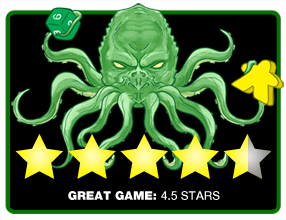 Hits:
Hits:
• A wealth of Information
• Organized nicely
• Applicable to new DMs and experienced
• Magic items fit with 5th edition’s goals
Misses:
• Some sections will probably rarely see use
• Limited appeal for DMs that don’t like to “tinker”




